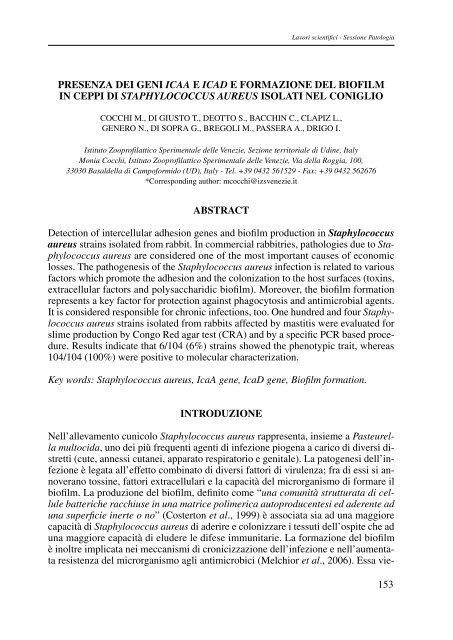atti delle giornate di coniglicoltura asic 2011 - Fondazione iniziative ...
atti delle giornate di coniglicoltura asic 2011 - Fondazione iniziative ...
atti delle giornate di coniglicoltura asic 2011 - Fondazione iniziative ...
Create successful ePaper yourself
Turn your PDF publications into a flip-book with our unique Google optimized e-Paper software.
Lavori scientifici - sessione Patologia<br />
pRESENZA dEI gENI icaa E icad E FORmAZIONE dEL bIOFILm<br />
IN cEppI dI StaphylococcuS aureuS ISOLATI NEL cONIgLIO<br />
CoCChi m., <strong>di</strong> GiusTo T., deoTTo s., baCChin C., CLaPiZ L.,<br />
Genero n., <strong>di</strong> soPra G., breGoLi m., Passera a., driGo i.<br />
Istituto Zooprofil<strong>atti</strong>co sperimentale <strong>delle</strong> Venezie, sezione territoriale <strong>di</strong> U<strong>di</strong>ne, Italy<br />
Monia Cocchi, Istituto Zooprofil<strong>atti</strong>co sperimentale <strong>delle</strong> Venezie, Via della Roggia, 100,<br />
33030 Basaldella <strong>di</strong> Campoformido (UD), Italy - Tel. +39 0432 561529 - Fax: +39 0432 562676<br />
*Correspon<strong>di</strong>ng author: mcocchi@izsvenezie.it<br />
AbSTRAcT<br />
detection of intercellular adhesion genes and biofilm production in Staphylococcus<br />
aureus strains isolated from rabbit. in commercial rabbitries, pathologies due to staphylococcus<br />
aureus are considered one of the most important causes of economic<br />
losses. The pathogenesis of the staphylococcus aureus infection is related to various<br />
factors which promote the adhesion and the colonization to the host surfaces (toxins,<br />
extracellular factors and polysacchari<strong>di</strong>c biofilm). moreover, the biofilm formation<br />
represents a key factor for protection against phagocytosis and antimicrobial agents.<br />
it is considered responsible for chronic infections, too. one hundred and four staphylococcus<br />
aureus strains isolated from rabbits affected by mastitis were evaluated for<br />
slime production by Congo red agar test (Cra) and by a specific PCr based procedure.<br />
results in<strong>di</strong>cate that 6/104 (6%) strains showed the phenotypic trait, whereas<br />
104/104 (100%) were positive to molecular characterization.<br />
Key words: staphylococcus aureus, IcaA gene, IcaD gene, Biofilm formation.<br />
INTROdUZIONE<br />
nell’allevamento cunicolo staphylococcus aureus rappresenta, insieme a Pasteurella<br />
multocida, uno dei più frequenti agenti <strong>di</strong> infezione piogena a carico <strong>di</strong> <strong>di</strong>versi <strong>di</strong>stretti<br />
(cute, annessi cutanei, apparato respiratorio e genitale). La patogenesi dell’infezione<br />
è legata all’effetto combinato <strong>di</strong> <strong>di</strong>versi fattori <strong>di</strong> virulenza; fra <strong>di</strong> essi si annoverano<br />
tossine, fattori extracellulari e la capacità del microrganismo <strong>di</strong> formare il<br />
biofilm. La produzione del biofilm, definito come “una comunità strutturata <strong>di</strong> cellule<br />
batteriche racchiuse in una matrice polimerica autoproducentesi ed aderente ad<br />
una superficie inerte o no” (Costerton et al., 1999) è associata sia ad una maggiore<br />
capacità <strong>di</strong> staphylococcus aureus <strong>di</strong> aderire e colonizzare i tessuti dell’ospite che ad<br />
una maggiore capacità <strong>di</strong> eludere le <strong>di</strong>fese immunitarie. La formazione del biofilm<br />
è inoltre implicata nei meccanismi <strong>di</strong> cronicizzazione dell’infezione e nell’aumentata<br />
resistenza del microrganismo agli antimicrobici (melchior et al., 2006). essa vie-<br />
153









